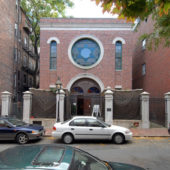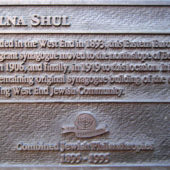Established by Eastern European Jews on Boston’s Beacon Hill
The Vilna Shul was built in 1919, primarily by immigrants from Vilna (now known as Vilnius), Lithuania. Many low income Jews were looking to rebuild their old communities, and settled in crowded tenement neighborhoods like Boston’s Beacon Hill. In 1893 a group of Jewish immigrants from Vilna, the countryside surrounding the city of Vilnius, Lithuania, formed a landsmanschaft in Beacon Hill. Praying together, they gathered a minyan, ten men needed to hold a completed Jewish prayer service, in their members’ homes. As their numbers increased, they formed an Orthodox Jewish congregation, which they called Anshei Vilner, the people of Vilnius, Lithuania. This lay the groundwork for the little synagogue of Vilna Shul.
At the turn of the century, Boston’s famous Beacon Hill was home to several immigrant communities as well as Boston’s African American community. As more Jews moved into the area, the African American community began to move away and in 1906, the 12th Baptist Church sold it’s building at 45 Philips Street to Anshei Vilner for $20,000. The church had seated 900 people and this was converted into a synagogue and ten years later demolished and expanded to include the Wendell Phillips School. Anshei Vilner laid the cornerstone for the new building, the Vilna Shul, on Decmber 11, 1919. Max Kalman, the architect, was the only Jewish architect in the city. However, the Shul is largely noteworthy not for its design, but for the fact that it is the last purpose-built immigrant-style synagogue in Boston. The Synagogue was originally decorated in the Eastern European style, with decorative murals painted on the walls and ceilings; however, these were eventually covered over in beige paint.
By the 1980’s the Jewish community had nearly all left the neighborhood and there was discussion whether to sell the building and give the proceeds to another congregation or turn it into a community center for residents of the neighborhood. The Synagogue remained active long active most of the other 50 synagogues in the City of Boston. As a result $3 million dollars was spent in renovating the Shul as a Jewish cultural heritage center while maintaining its original character.
Currently, a tour through Villa Shul reveals patches of plaster and peeling paint, with areas of beautiful murals layered on top of each other adorning the walls. Simply carved arched wood-framed windows and doors with stained glass line the sides and front of the Shul. Wooden benches pre-dating the building and which are mildly uncomfortable after prolonged sitting, complement the woodwork of the window frames and doors. Light bulb-laden chandeliers drop from the ceilings. Lanterns surround the bima and platform, from where the service is performed. The large skylight adds additional natural light over the platform, “enlightening” those leading the service. Vilna Shul looks much as it must have nearly a century ago. The building itself is tucked away amongst old tenement buildings.
At the end of the first decade of the 21st century, The Boston Center for Jewish Heritage opens the building daily for an exhibit of the history of the synagogue and of the Boston Jewish Community. There are a variety of events hosted at the Shul, ranging from a Yiddish film series to lectures about social entrepreneurship and the restoration of synagogue wall art. One Friday a month the Vilna Shul is open for Shabbat services, known as Havurah on a Hill. This is attended largely by a young crowd (20s and 30s), and is non-denominational and lay-led. After the service, there is a speaker, followed by a kosher buffet dinner. The speakers discuss topics often pulling from personal experience, which are, not unexpectedly, often from Judaism. 2006 was the first time in approximately 20 years the Vilna Shul had offered services on Yom Kippur. In 2007 they held services for both Rosh Hashanah and Yom Kippur.
The Vilna Shul endeavors to remain a relevant social and spiritual haven for the neighborhood of Beacon Hill. The Shul also stands as an historic marker of the thriving Jewish immigrant community that lived on Beacon Hill, of decades gone by.




